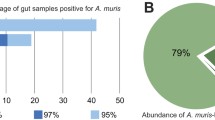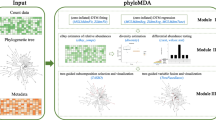Abstract
A web-based resource, Microbial Community Analysis (MiCA), has been developed to facilitate studies on microbial community ecology that use analyses of terminal-restriction fragment length polymorphisms (T-RFLP) of 16S and 18S rRNA genes. MiCA provides an intuitive web interface to access two specialized programs and a specially formatted database of 16S ribosomal RNA sequences. The first program performs virtual polymerase chain reaction (PCR) amplification of rRNA genes and restriction of the amplicons using primer sequences and restriction enzymes chosen by the user. This program, in silico PCR and Restriction (ISPaR), uses a binary encoding of DNA sequences to rapidly scan large numbers of sequences in databases searching for primer annealing and restriction sites while permitting the user to specify the number of mismatches in primer sequences. ISPaR supports multiple digests with up to three enzymes. The number of base pairs between the 5′ and 3′ primers and the proximal restriction sites can be reported, printed, or exported in various formats. The second program, APLAUS, infers a plausible community structure(s) based on T-RFLP data supplied by a user. APLAUS estimates the relative abundances of populations and reports a listing of phylotypes that are consistent with the empirical data. MiCA is accessible at http://mica.ibest.uidaho.edu/.




Similar content being viewed by others
References
Borneman, J, Triplett, EW (1997) Molecular microbial diversity in soils from eastern Amazonia: evidence for unusual microorganisms and microbial population shifts associated with deforestation. Appl Environ Microbiol 63: 2647–2653
Buckley, DH, Schmidt, TM (2001) The structure of microbial communities in soil and the lasting impact of cultivation. Microb Ecol 42: 11–21
Chandler, DP, Fredrickson, JK, Brockman, FJ (1997) Effect of PCR template concentration on the composition and distribution of total community 16S rDNA clone libraries. Mol Ecol 6: 475–483
Cole, JR, Chai, B, Marsh, TL, Farris, RJ, Wang, Q, Kulam, SA, Chandra, S, McGarrell, DM, Schmidt, TM, Garrity, GM, Tiedje, JM (2003) The Ribosomal Database Project (RDP-II): previewing a new autoaligner that allows regular updates and the new prokaryotic taxonomy. Nucleic Acids Res 31: 442–443
DeLong, EF, Pace, NR (2001) Environmental diversity of bacteria and archaea. Syst Biol 50: 470–478
Dunbar, J, White, S, Forney, LJ (1997) Genetic diversity through the looking glass: effect of enrichment bias. Appl Environ Microbiol 63: 1326–1331
Dunbar, J, Barns, SM, Ticknor, LO, Kuske, CR (2002) Empirical and theoretical bacterial diversity in four Arizona soils. Appl Environ Microbiol 68: 3035–3045
Ercolini, D, Moschetti, G, Blaiotta, G, Coppola, S (2001) The potential of a polyphasic PCR-DGGE approach in evaluating microbial diversity of natural whey cultures for water-buffalo mozzarella cheese production: bias of culture-dependent and culture-independent analysis. Syst Appl Microbiol 24: 610–617
Farrelly, V, Rainey, FA, Stackebrandt, E (1995) Effect of genome size and rrn gene copy number on PCR amplification of 16S rRNA genes from a mixture of bacterial species. Appl Environ Microbiol 61: 2798–2801
Frostegård, Å, Courtois, S, Ramisse, V, Clerc, S, Bernillon, D, Le Gall, F, Jeannin, P, Nesme, X, Simonet, P (1999) Quantification of bias related to the extraction of DNA directly from soils. Appl Environ Microbiol 65: 5409–5420
Hillebrand, H, Watermann, F, Karez, R, Berninger, UG (2001) Differences in species richness patterns between unicellular and multicellular organisms. Oecologia 126:114–124
Kent, AD, Smith, DJ, Benson, BJ, Triplett, EW (2003) Web-based phylogenetic assignment tool for analysis of terminal restriction fragment length polymorphism profiles of microbial communities. Appl Environ Microbiol 69: 6768–6776
Kousuke, I, Fukui, M (2001) Optimization of annealing temperature to reduce bias caused by a primer mismatch in multitemplate PCR. Appl Environ Microbiol 67: 3753–3755
Kowalchuk, GA, Stienstra, AW, Heilig, GHJ, Stephen, JR, Woldendorp, JW (2000) Changes in the community structure of ammonia-oxidizing bacteria during secondary succession of calcareous grasslands. Environ Microbiol 2: 99–110
Lexa, M, Horak, J, Brzobohaty, B (2000) Virtual PCR. Bioinformatics 17: 192–193
Liu, WT, Marsh, TL, Cheng, H, Forney, LJ (1997) Characterization of microbial diversity by determining terminal restriction fragment length polymorphisms of genes encoding 16S rRNA. Appl Environ Microbiol 63: 4516–4522
Marsh, TL, Saxman, P, Cole, J, Tiedje, J (2000) Terminal restriction fragment length polymorphism analysis program, a web-based research tool for microbial community analysis. Appl Environ Microbiol 66: 3616–3620
Michel Jr, FC, Sciarini, SM (2004) Fragsort 4.0, a tool for multiple restriction digestion T-RFLP analysis based on in silico amplification and digestion of 16S ribosomal RNA gene sequences. In: Proceedings of the 10th International Symposium on Microbial Ecology (ISME-10), Poster Session P03C
Muyzer, G, de Waal, EC, Uitterlinden, AG (1993) Profiling of complex microbial populations by denaturing gradient gel electrophoresis analysis of polymerase chain reaction-amplified genes coding for 16S rRNA. Appl Environ Microbiol 59: 695–700
Polz, MF, Cavanaugh, CM (1998) Bias in template-to-product ratios in multitemplate PCR. Appl Environ Microbiol 64: 3724–3730
Reysenbach, A-L, Giver, LJ, Wickham, GS, Pace, NR (1992) Differential amplification of rRNA genes by polymerase chain reaction. Appl Environ Microbiol 58: 3417–3418
Schuler, GD (1997) Sequence mapping by electronic PCR. Genomic Methods 7: 541–550
Smith, Z, McCaig, AE, Stephen, JR, Embley, TM, Prosser, JI (2001) Species diversity of uncultured and cultured populations of soil and marine ammonia oxidizing bacteria. Microb Ecol 42: 228–237
Suzuki, M, Giovannoni, SJ (1996) Bias caused by template annealing in the amplification mixtures of 16S rRNA genes by PCR. Appl Environ Microbiol 62: 625–630
Tiedje, JM, Asuming-Brempong, S. Nusslein, K. Marsh, TL, Flynn, SJ (1999) Opening the black box of soil microbial diversity. Appl Soil Ecol 13: 109–112
Ward, BB (2002) How many species of prokaryotes are there? Proc Natl Acad Sci USA 99: 10234–10236
Ward, DM, Ferris, MJ, Nold, SC, Bateson, MM (1998) A natural view of microbial biodiversity within hot spring cyanobacterial mat communities. Microbiol Mol Biol Rev 62: 1353–1370
Wise, MJ, Osborn, AM (2001) TRUFFLER: programs to study microbial community composition and flux from fluorescent DNA fingerprinting data. Proceedings of 2nd IEEE International Symposium on Bioinformatics and Bioengineering (BIBE '01), p 129
Acknowledgment
This research was supported by a grant from Procter and Gamble to J.A.F. and L.J.F. and by a grant from the National Institutes of Health (NIH NCRR IP20 RR16448) to L.J.F.
Author information
Authors and Affiliations
Corresponding author
Rights and permissions
About this article
Cite this article
Shyu, C., Soule, T., Bent, S.J. et al. MiCA: A Web-Based Tool for the Analysis of Microbial Communities Based on Terminal-Restriction Fragment Length Polymorphisms of 16S and 18S rRNA Genes. Microb Ecol 53, 562–570 (2007). https://doi.org/10.1007/s00248-006-9106-0
Received:
Accepted:
Published:
Issue Date:
DOI: https://doi.org/10.1007/s00248-006-9106-0




